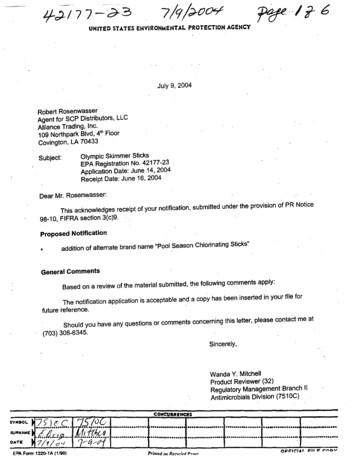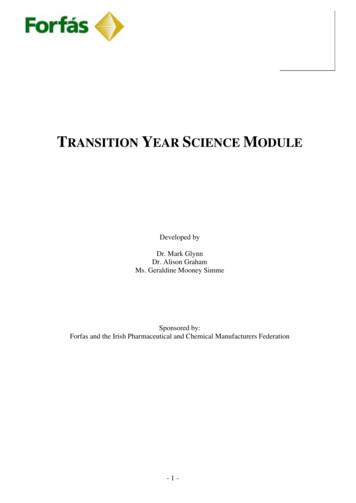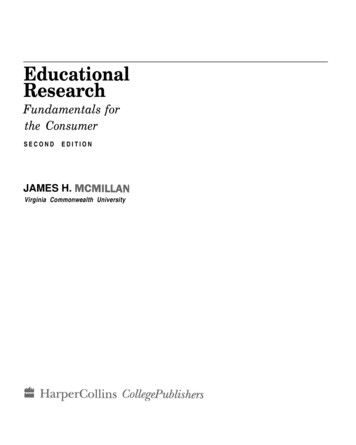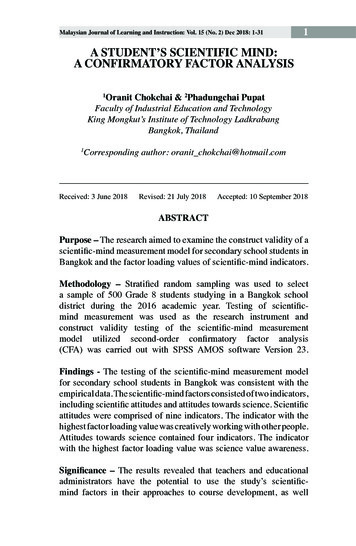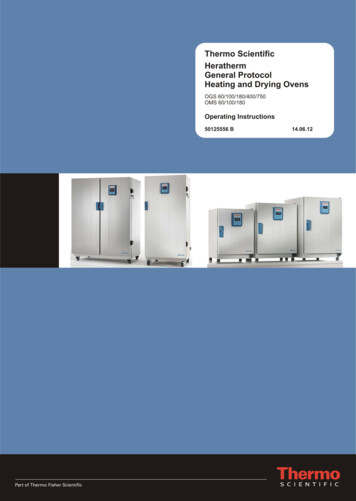
Transcription
February 13, 2004MEMORANDUMSUBJECT:Transmittal of Meeting Minutes of the FIFRA Scientific Advisory Panel MeetingHeld December 3-5, 2003TO:James J. Jones, DirectorOffice of Pesticide ProgramsFROM:Paul I. Lewis, Designated Federal OfficialFIFRA Scientific Advisory PanelOffice of Science Coordination and PolicyTHRU:Larry C. Dorsey, Executive SecretaryFIFRA Scientific Advisory PanelOffice of Science Coordination and PolicyJoseph J. Merenda, Jr., DirectorOffice of Science Coordination and PolicyPlease find attached the meeting minutes of the FIFRA Scientific Advisory Panel openmeeting held in Arlington, Virginia from December 3-5, 2003. This report addresses a set ofscientific issues being considered by the Environmental Protection Agency regarding a draftpreliminary probabilistic exposure and risk assessment for children who contact CCA-treatedwood on playsets and decks and CCA-containing soil around these structures.AttachmentPage 1 of 70
cc:Susan HazenAdam SharpAnne LindsayJanet AndersenDebbie EdwardsSteven BradburyWilliam DiamondArnold LayneTina LevineLois RossiFrank SandersMargaret StasikowskiWilliam JordanDouglas ParsonsDaniel RosenblattDavid DeeganVanessa Vu (SAB)OPP DocketFIFRA Scientific Advisory Panel MembersSteven Heeringa, Ph.D.Fumio Matsumura, Ph.D.Mary Anna Thrall, D.V.M.FQPA Science Review Board MembersJohn Adgate, Ph.D.Michael Bates, Ph.D.Chi-Hsin Selene Jen Chou, Ph.D.Natalie Freeman, Ph.D.Marcie Francis, Ph.D.Dale Hattis, Ph.D.John Kissel, Ph.D.Stan Lebow, Ph.D.Peter Macdonald, D. Phil.David MacIntosh, Sc.D.Kenneth Portier, Ph.D.Nu-May Ruby Reed, Ph.D.Jim E. Riviere, DVM, Ph.D.Barry Ryan, Ph.D.Page 2 of 70
Jacob Steinberg, M.D.David Stilwell, Ph.D.Miroslav Styblo, Ph.D.Donald Wauchope, Ph.D.Page 3 of 70
SAP Meeting Minutes No. 2003-04MEETING MINUTESFIFRA Scientific Advisory Panel Meeting,December 3-5, 2003, held at the Sheraton Crystal City HotelArlington, VirginiaA Set of Scientific Issues Being Considered by theEnvironmental Protection Agency Regarding:Draft Preliminary Probabilistic Exposure And RiskAssessment For Children Who Contact CCA-Treated WoodOn Playsets And Decks And CCA-Containing Soil AroundThese StructuresPage 4 of 70
NOTICEThese meeting minutes have been written as part of the activities of the FederalInsecticide, Fungicide, and Rodenticide Act (FIFRA), Scientific Advisory Panel (SAP).This report has not been reviewed for approval by the United States EnvironmentalProtection Agency (Agency) and, hence, the contents of this report do not necessarilyrepresent the views and policies of the Agency, nor of other agencies in the ExecutiveBranch of the Federal government, nor does mention of trade names or commercialproducts constitute a recommendation for use.The FIFRA SAP was established under the provisions of FIFRA, as amended bythe Food Quality Protection Act (FQPA) of 1996, to provide advice, information, andrecommendations to the Agency Administrator on pesticides and pesticide-related issuesregarding the impact of regulatory actions on health and the environment. The Panelserves as the primary scientific peer review mechanism of the EPA, Office of PesticidePrograms (OPP) and is structured to provide balanced expert assessment of pesticide andpesticide-related matters facing the Agency. Food Quality Protection Act ScienceReview Board members serve the FIFRA SAP on an ad hoc basis to assist in reviewsconducted by the FIFRA SAP. Further information about FIFRA SAP reports andactivities can be obtained from its website at http://www.epa.gov/scipoly/sap/ or the OPPDocket at (703) 305-5805. Interested persons are invited to contact Paul Lewis, FIFRASAP Designated Federal Official, via e-mail at lewis.paul@epa.govPage 5 of 70
TABLE OF CONTENTSPARTICIPANTS .8PUBLIC COMMENTERS.9INTRODUCTION .10CHARGE .11SUMMARY OF PANEL DISCUSSION AND RECOMMENDATIONS .16PANEL DELIBERATIONS AND RESPONSE TO THE CHARGE .20REFERENCES .68Page 6 of 70
SAP Meeting Minutes No. 2003-04Meeting Minutes:FIFRA Scientific Advisory Panel Meeting,December 3-5, 2003, held at the Sheraton Crystal CityHotel, Arlington, VirginiaA Set of Scientific Issues Being Considered by theEnvironmental Protection Agency Regarding:Draft Preliminary Probabilistic Exposure And RiskAssessment For Children Who Contact CCA-TreatedWood On Playsets And Decks And CCA-ContainingSoil Around These StructuresMr. Paul LewisDesignated Federal OfficialFIFRA Scientific Advisory PanelDate: February 13, 2004Page 7 of 70Steven Heeringa, Ph.D.FIFRA SAP Session ChairFIFRA Scientific Advisory PanelDate: February 13, 2004
Federal Insecticide, Fungicide, and Rodenticide ActScientific Advisory Panel MeetingDecember 3-5, 2003Draft Preliminary Probabilistic Exposure And Risk Assessment For ChildrenWho Contact CCA-Treated Wood On Playsets And DecksAnd CCA-Containing Soil Around These StructuresPARTICIPANTSFIFRA SAP Session ChairSteven Heeringa, Ph.D., Research Scientist & Director for Statistical Design, Institute forSocial Research, University of Michigan, Ann Arbor, MIFIFRA Scientific Advisory Panel MembersFumio Matsumura, Ph.D., Professor, Environmental Toxicology and Director, Center forEnvironmental Health Sciences, c/o Dept. Environmental Toxicology, University ofCalifornia at Davis, DavisMary Anna Thrall, D.V.M., Professor, Department of Pathology, College of Veterinary &Biomedical Sciences, Colorado State University, Fort Collins, COFQPA Science Review Board MembersJohn Adgate, Ph.D., Assistant Professor, Division of Environmental and OccupationalHealth, University of Minnesota School of Public Health, Minneapolis, MNMichael Bates, Ph.D., Adjunct Professor of Epidemiology, School of Public Health,University of California, Berkeley, CAChi-Hsin Selene Jen Chou, Ph.D., Environmental Health Scientist, Division ofToxicology, Scientific Assessment Section, Agency for Toxic Substance and DiseaseRegistry, Atlanta, GANatalie Freeman, Ph.D., Adjunct Associate Professor, Environmental/CommunityMedicine, Robert Wood Johnson School of Medicine, Piscataway, NJMarcie Francis, Ph.D. CIH, Senior Research Scientist, Battelle Memorial Institute,Kensington, MDDale Hattis, Ph.D., Research Professor, Center for Technology, Environment andDevelopment, George Perkins Marsh Institute, Clark University, Arlington, MAJohn Kissel, Ph.D., Associate Professor, Environmental Health, University of Washington,Page 8 of 70
Seattle, WAStan Lebow, Ph.D., USDA Forest Service, Forest Products Laboratory, Madison, WIPeter Macdonald, D. Phil., Professor of Mathematics and Statistics, Department ofMathematics and Statistics, McMaster University, Hamilton, Ontario, CanadaDavid MacIntosh, Sc.D., Senior Associate, Environmental Health and Engineering, Inc.Newton, MAKenneth Portier, Ph.D., Associate Professor, Statistics, Institute of Food and AgriculturalSciences, University of Florida, Gainesville, FLNu-May Ruby Reed, Ph.D., Staff Toxicologist, California EPA, Dept. of PesticideRegulation, Sacramento, CAJim E. Riviere, D.V.M., Ph.D., Burroughs Wellcome Fund Distinguished Professor andDirector, Center for Chemical Toxicology Research and Pharmacokinetics, Department ofPopulation Health and Pathobiology, College of Veterinary Medicine, North Carolina StateUniversity, Raleigh, NCBarry Ryan, Ph.D., Professor, Department of Environmental and Occupational Health,Rollins School of Public Health, Emory University, Atlanta, GAJacob Steinberg, M.D., Professor of Pathology, Montefiore Medical Center, Albert EinsteinCollege of Medicine, Bronx, NYDavid Stilwell, Ph.D., University of Connecticut, Connecticut Agricultural ExperimentStation, New Haven, CTMiroslav Styblo, Ph.D., Research Associate Professor, Department of Pediatrics, Universityof North Carolina at Chapel Hill, Chapel Hill, NCDonald Wauchope, Ph.D., Research Chemist, Southwest Watershed Research Lab, USDA,Agricultural Research Service, Tifton, GAPUBLIC COMMENTERSOral statements were made by:Barbara Beck, Ph.D. (Gradient) on behalf of the Wood Preservative Science CouncilChris Chaisson, Ph.D. (Lifeline Group) on behalf of the American Chemistry CouncilFloyd Frost, Ph.D. (Lovelace Research Institute) on behalf of the Wood Preservative ScienceCouncilMr. John Horton (Osmose) on behalf of the Wood Preservative Science CouncilPage 9 of 70
Ms. Jane Houlihan (Environmental Working Group)Steven Lamm, M.D. (Consultants in Epidemiology & Occupational Health, Inc; JohnsHopkins University-Bloomberg School of Public Health, Department of Health Policy andManagement)Yvette Lowney, Ph.D. (Exponent) on behalf of Georgia PacificBarbara Petersen, Ph.D. (Exponent) on behalf of Georgia PacificMike Ruby, Ph.D. (Exponent) on behalf of Georgia PacificRaj Sharma, Ph.D. (Arch Chemical Company) on behalf of the Wood Preservative ScienceCouncilLeonard Smith, Ph.D. (State University of New York, ESF) on behalf of the Treated WoodCouncilHelena Solo-Gabriele, Ph.D. (University of Miami) on behalf of the University of Miami,University of Florida, and Florida International University Collaborative CCA-treated WoodResearchJoyce Tsuji, Ph.D. (Exponent) on behalf of the American Chemistry CouncilWritten statements were received from:American Chemistry Council’s CCA Task ForceSteven Lamm, M.D. (Consultants in Epidemiology & Occupational Health, Inc; JohnsHopkins University-Bloomberg School of Public Health Department of Health Policy andManagement)Helena Solo-Gabriele, Ph.D. (University of Miami) on behalf of the University ofMiami/University of Florida, Florida International University Collaborative CCA-TreatedWood ResearchCarter Holt HarveyMichele Lafantaisie (private citizen)Andrew Wegmann (private citizen)Wood Preservative Science CouncilINTRODUCTIONThe Federal Insecticide, Fungicide, and Rodenticide Act (FIFRA), ScientificPage 10 of 70
Advisory Panel (SAP) has completed its review of the set of scientific issues beingconsidered by the Agency pertaining to its Draft Preliminary Probabilistic Exposure AndRisk Assessment For Children Who Contact CCA-Treated Wood On Playsets And DecksAnd CCA-Containing Soil Around These Structures. Advance notice of the meeting waspublished in the Federal Register on September 26, 2003. The review was conducted in anopen Panel meeting held in Arlington, Virginia, from December 3-5, 2003. The meeting waschaired by Steven Heeringa, Ph.D. Mr. Paul Lewis served as the Designated FederalOfficial. Mr. William Jordan (Office of Pesticide Programs, EPA) provided an introductionon the goals and objectives of the session. Halfk Özkaynak, Ph.D. (Office of Research andDevelopment, EPA) offered an introduction to the SHEDS-Wood model assessment forCCA. Valerie Zartarian, Ph.D. (Office of Research and Development, EPA) presented asummary of SHEDS-Wood model methodology, inputs for the CCA exposure assessmentand the SHEDS-Wood ADD and LADD results for the CCA assessment. Halfk Özkaynak,Ph.D. (Office of Research and Development, EPA) highlighted the strengths and limitationsof the probabilistic exposure and dose assessment. Winston Dang, Ph.D. M.P.H. (Office ofPesticide Programs, EPA) provided an introduction on the goals and objectives of theprobabilistic CCA risk assessment, CCA risk analysis and results. Dr. Dang concluded theAgency’s presentation by highlighting the strengths and weaknesses of the probabilistic riskassessment.In preparing these meeting minutes, the Panel carefully considered all informationprovided and presented by the Agency presenters, as well as information presented by publiccommenters. This document addresses the information provided and presented within thestructure of the charge by the Agency.CHARGEIssue 1: Documentation, completeness, and clarity of the model source code and theexposure assessment reportBoth the SHEDS-Wood source code and the probabilistic exposure assessment report have beensignificantly revised since the August 2002 SAP.Question A: The Source Code Directory on the CD provided to the SAP includes annotatedcode for the exposure and dose algorithms used in the SHEDS-Wood model. Are thesealgorithms consistent with the descriptions in the SHEDS-Wood CCA exposure assessmentreport? Does the revised SHEDS-Wood version 2 code (i.e., the code submitted for theDecember 2003 SAP) accurately reflect changes to the version 1 methodology (i.e., the code andmethodology presented to the August 2002 SAP) described in the report?Question B: The SHEDS-Wood CCA exposure assessment report presents the model construct,selected model inputs, model results, and comparison to other CCA model estimates. Pleasecomment on the clarity, completeness and usefulness of this document.Issue 2. Modifications to SHEDS-Wood model code and the exposure scenarios selectedA number of modifications to the model code and scenario-specific changes have been made tothe SHEDS-Wood model since the August 2002 SAP.Page 11 of 70
Question A: Considering the limitations of available information and state-of-the-art modelingmethods required for the assessment of children’s exposures from contacting CCA treated woodresidues and CCA containing soil, are the revisions made to the SHEDS-Wood code oralgorithms scientifically sound and acceptable ?Question B: The SHEDS-Wood model has been modified using feedback from the August 2002SAP. In particular, the recent assessment, includes: assessment of exposures of childrencontacting only CCA treated public playsets; sensitivity of results to changing the age group ofexposed children to 1-13 years, and; a separate analysis for children exhibiting pica soilingestion behavior. The Panel is requested to comment on the appropriateness of the newexposure scenarios in the revised probabilistic exposure and dose assessment.Issue 3. Key input variables and specification of associated variability distributionsSensitivity and uncertainty analyses of the SHEDS-Wood model results identified the followingas key input variables influencing the model results: wood surface residue-to-skin transferefficiency; wood surface residue levels; fraction of hand surface area mouthed per mouthingevent; and GI absorption fraction for residues. In addition to the above variables, sensitivity anduncertainty analyses also indicated the importance of following additional variables: averagenumber of days per year a child plays around CCA-treated playsets, frequency of hand washing,daily soil ingestion rate, and average fraction of non-residential time a child plays on/aroundCCA-treated playsets.Question A. Has the Agency used the best available information for developing inputdistributions for these variables? If not, are there any other data that EPA should be aware of?Considering the limitations and uncertainties with available information, are the choices made indeveloping distributions for each of these key variables using the available informationreasonable and scientifically sound?Question B. In some of these instances (see Table 12, page 58), because of data limitations, theAgency has made simplifying assumptions to represent them as point estimates based onprofessional judgment. Are the simplifying assumptions presented in the draft exposureassessment for making these decisions adequately supported by relevant scientific data? Are thechoices made to quantify these variables (i.e., selected distributions or point estimates)reasonable and sound?Question C. Are the methods used for fitting variability distributions that are assigned to modelinput variables for the CCA assessment appropriate?Question D. The Panel is requested to comment on whether any other model inputs are eitherkey drivers of results or sources of large model uncertainty. Do these model input variables andthe distributions assigned to them appropriately reflect available scientific data? Did EPAappropriately integrate the available data to derive the distributions for these input variables?Page 12 of 70
Issue 4: Methods and results for sensitivity and uncertainty analysesEPA's draft CCA Exposure Assessment includes a formal sensitivity and uncertainty analysis aswell as discussion of various sources of uncertainty in the model analyses.Question A: The Panel is requested to comment on the utility and suitability of the statisticaldiagnostic tools used by SHEDS for analyzing model results (e.g., variability analyses,sensitivity analyses, uncertainty analyses).Question B: Is the bootstrap approach that is used for fitting uncertainty distributions, whichhas been revised in response to prior SAP comments, implemented properly, or are therealternative approaches that are recommended?Question C: Are the uncertainty distributions assigned to chemical and non-chemical specificmodel input parameters appropriate?Question D: The Panel is requested to comment on whether the modeling approach anddocumentation appropriately identify and address critical sources of uncertainty in the model andthe resulting exposure estimates. Does EPA’s documentation adequately describe theuncertainties inherent in the data used for modeling and the influence of these uncertainties oninterpretation of the modeling results?Question E. Does the Panel recommend performing any additional uncertainty analyses toevaluate the impacts of using alternative input distributions on the modeling results (e.g., toaddress uncertainties in various factors determining the frequency of children's exposures toCCA-treated wood in playsets and decks)?Issue 5: Special Model SimulationsA number of special simulations with the SHEDS-Wood model were conducted in order toexamine the importance of specific exposure scenarios or the impact of certain inputassumptions. For example, some of these analyses included conducting separate simulations forchildren exposed to public playsets only, modeling exposures of the 7-13 year old age group, andstudying exposures of children exhibiting pica behavior. Additional analyses were alsoconducted to examine the impacts of using data or assumptions about increased GI absorption,decreased dermal absorption, lowering the transferable wood residue concentrations by sealants,and hand washing after play events. The results from these special analyses were notsignificantly different than the baseline model results, except for the large impact of assumingthe use of sealants would greatly reduce wood residues.Question A. The Panel is requested to comment on the appropriateness of the justifications madein characterizing the key factors or inputs for each of these special simulations. Did the Agencyprovide adequate technical rationale and justification for its choices for these alternativeexposure scenarios or input distributions? Do the results from these special analyses reflectproper use of available information?Page 13 of 70
Question B: Do any of the findings from these special analyses necessitate the Agency toconsider revising certain scenarios or inputs to the baseline assessment?Issue 6: Evaluation of the SHEDS-Wood model resultsThe Agency has evaluated the probabilistic CCA exposure model results by comparing them toresults from other earlier deterministic CCA assessments. In particular, the SHEDS-Wood modelresults were found to compare well to a deterministic CCA assessment performed by theGradient Corporation, and SHEDS-Wood upper percentiles compare well to deterministicConsumer Product Safety Commission estimates.Question A: Has EPA provided adequate documentation of the overall plausibility of theexposure estimates generated by the SHEDS-Wood model for CCA? Are the comparisons withthe results of other selected exposure assessments appropriate and appropriately presented? Arethere any other types of benchmarking approaches or data to assess the reliability of the overallexposure model or specific model elements?Issue 7: Overall completeness and acceptability of the SHEDS-Wood probabilistic CCAexposure assessmentEPA has revised the August 2002 SHEDS-Wood exposure assessment after carefullyconsidering numerous comments and suggestions that it has received from various parties,including those from the August 2002 FIFRA SAP members, EPA/ORD and EPA ProgramOffice peer-reviewers of the preliminary draft September 2003 report, and from the generalpublic and other external groups.Question A: In addition to the comments and suggestions already offered by the Panel membersunder the specific issues raised previously, considering the availability of data and information,does the Panel recognize any critical gaps in information or methodologies that still need to beaddressed for the CCA exposure and dose assessment?Issue 8: In the study by Nico et al. (2003), X-ray absorption spectroscopy (XAS) was used todetermine the chemical and structural state of arsenic and chromium molecules in CCA-treatedwood residue samples. Based on the results of their analysis, Nico et al. (2003) determined thatarsenic and chromium formed a “chemical complex bonded to the wood structure.” Based onthis study, the dominant oxidation state of the two elements is As(V) and Cr(III), and the localchemical environment of the two elements is best represented as a stable Cr/As cluster consistingof a Cr dimer bridged by an As(V) oxygen ion. Nico et al. (2003) also maintained that thischemical complex was quite resistant to leaching.Question A: The Panel is requested to comment on the Nico et. al. (2003) study and particularlyon the arsenic and chromium chemical complex from CCA treated wood surface residue, andwhether the Panel believes that the chemical complex is formed during the fixation process.What is the meaning of this complex cluster formation to the current risk assessment.Page 14 of 70
Issue 9. Casteel et al. (2003), reported that the relative bioavailability (RBA) of dislodgeablewood residue is 27%. This value is significantly lower than the default value of 100% that isusually employed when reliable site-specific data are lacking and also lower than the RBA valuerecommended by the SAP 2001. The result of this study indicates that the arsenic in thedislodgeable arsenic material is not as well absorbed as soluble arsenic.Question A: Does the Panel agree that, in light of the Casteel study and the Nico study discussedin issue 8, the Agency should use 27% for the RBA to estimate the bioavailable dose.Issue 10: In the 2001 SAP meeting, the Panel cited the research of Wester et al. (1993) as asource of the dermal absorption rate of soluble arsenic in water and soil. The Panelrecommended using a 2-3 % dermal absorption rate for arsenic residue on the surface of wood.Recently, a preliminary study by Wester et al. (2003) that has been submitted by the samelaboratory compares the dermal absorption of arsenic in CCA-treated wood surface residues witharsenic in water solution. Although the Agency has not received the complete results of thisstudy (e.g., the recovery of the arsenic in the urine of the animal given IV dose of arsenic), thepreliminary results of this study indicate that the dermal absorption of 0.01% from wood surfaceresidue was approximately two orders of magnitude lower than the results in water. The dermalabsorption from this study was based on urinary arsenic data following application of arsenic inCCA-treated wood residue that had been weathered by the environment.Question A: Taking into consideration the Nico et al. study mentioned in issue 8, the Panel isrequested to comment on whether this new study conducted by Wester et al. provides a moreappropriate estimate of dermal absorption from contact with CCA-treated wood surfaces thanthe earlier 1993 Wester et al. study.Issue 11: In the 2001 SAP meeting, the Panel recommended that a biomonitoring study beperformed on children who are normally exposed to CCA-treated playground equipment anddecks. The Panel recommended that the study should be designed according to well-acceptedepidemiological principles, including adequate sample size, to resolve the issue of whether thereare substantial exposures to children from arsenic residues after playing on decks and playsets.The Panel indicated data from such a biomonitoring study could be directly used in the riskassessment and could be used to validate the exposure assessment model. Recently, a proposedprotocol for a pilot study was submitted to OPP for peer review; this proposed protocol is anattempt to determine if changes in exposure to arsenic can be assessed by examining changes inthe urinary excretion of arsenic. EPA has provided the Panel with a copy of the proposedprotocol for the pilot study. In summary, the proposed pilot study will determine whether asignificant difference in urinary arsenic can be discerned when a population of children areswitched from arsenic-containing tap water to an essentially arsenic-free source of drinkingwater.Question A. The Panel is requested to comment on the strengths and limitations of the approachto be employed in the proposed pilot study to help resolve the issue of whether there aresubstantial exposures to children from arsenic residues after playing on decks and playsets. InPage 15 of 70
particular, please comment on the feasibility, the potential confounding background sources fromthe statistical analysis, the sensitivity and accuracy of analytical method for quantification ofarsenic in urine to detect changes, the determination of intraindividual variation andinterindividual variation based on the current knowledge of exposure; and any other aspects ofthe proposed pilot study that might affect its utility.Question B. The Panel is asked to describe approaches for gathering additional data – e.g., dataon the efficiency of transfer of surface residues to the skin surface (which has been identified asone of most critical model inputs based on the uncertainty analysis) – to improve the estimates ofexposure and / or the level of confidence in such estimates, and with respect to these approaches,as well as the proposed pilot study, to comment on the cost of data generation, the amount oftime to generate the data, and the degree to which the data will reduce uncertainty about theaccuracy of the model estimates.Issue 12. Prior to the availability of probabilistic models, such as SHEDS, OPP estimated thelifetime average daily dose (LADD) and corresponding cancer risk to pesticides via adeterministic approach using central tendency input parameters (median or mean values).Probabilistic models now allow OPP to express input parameters as distributions andsubsequently generate a distribution of LADDs and corresponding pesticide cancer risks. Inother words, the deterministic approach results in a single cancer risk value and the probabilisticapproach results in a distribution of cancer risk values.Question A. The Panel is requested to comment on whether in this probabilistic approach ofusing the upper bound arsenic cancer slope factor combined with using high-end LADDs wouldresult in a significant overestimation of the risk for the more highly exposed percentiles of thepopulation? If this is an overestimate, what other values would the panel recommended using asreplacements, or in addition to the values that were used that would minimize the overestimationof risk without substantially underestimating the risk for such percentiles.In this assessment, the estimated risks are considered approximations because inaccuracies mayoccur when exposures are summed across routes at the quartile level especially in the upperpercentile. This is due to the way the Monte Carlo simulations were conducted and the outputssummarized.Question B. The Panel is requested to comment on the range of percentiles, if any, at whichthere is a significant decrease in the reliability of the estimates of risk.SUMMARY OF PANEL DISCUSSION AND RECOMMENDATIONSIssue 1: Documentation, completeness, and clarity of the model source code and theexposure assessment reportThe Panel concluded that the algorithms used in the model align with those identified inthe exposure assessment report. The model was correctly programmed and the advice fromprevious FIFRA SAPs has been accurately incorporated and well documented. The exposurePage 16 of 70
assessment documentation is clear. The tables of user-specified assumptions are extensive butthe assumptions hard-coded in the scripts could be highlighted better.Issue 2. Modifications to SHEDS-Wood model code and the exposure scenarios selectedThe general consensus of the Panel was that the current SHEDS-Wood modelimplementation represented a good faith effort on the part of the Agency. Even though one canquestion specific choices of distributional assumptions, overall the work seemed a reasonableeffort and a sound basis for risk assessment within the limitations of available information.It is clear to the Panel that the SHEDS-Wood model code is flexible enough to implementany reasonable new scenarios, given that distributions and associated parameter estimates of therandom variable components of the scenario model can be specified. The Panel commented thatanyone reviewing the current scenarios understands their limitations, including that theunderlying population whose risk is being assessed is NOT children in general but is limitedspecifically to children contacting only CCA-treated public play sets. It was felt that thispopulation limitation should be emphasized more in the documentation to avoid confusing thepublic. It is clear that this is not a populat
represent the views and policies of the Agency, nor of other agencies in the Executive Branch of the Federal government, nor does mention of trade names or commercial products constitute a recommendation for use. The FIFRA SAP was established under the provisions of FIFRA, as amended by

